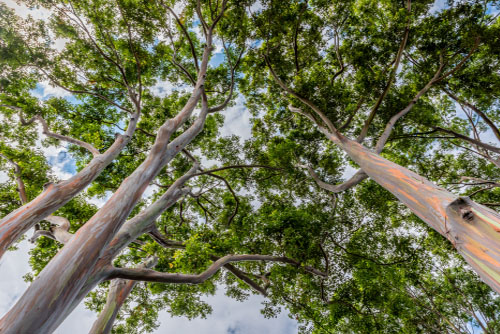Tree care is an important topic and it is a mystery for some of the newbies. Educating oneself with the best information available about tree care helps in making smart decisions when comes to handling the trees. We found an interesting article about “Tree Care” in the book called “TREE AND SHRUB GARDENING FOR NORTHERN CALIFORNIA” by “Bob Tanem” and “Don Williamson”, Here is a small snippet of the article for our users.
CARING FOR WOODY PLANTS
The care you give your new tree or shrub in the first year or two after planting is the most important. During this period of establishment, it is critical to keep the plant well watered and fed, to remove completing weeds and avoid all mechanical damage. Be careful with lawn mowers and string trimmers, which can quickly girdle the base of the tree and cut off the flow of food and water between roots and branches. Remember that whatever you do to the top of the plant affects the roots, and vice versa.
Once trees and shrubs are established , the generally require minimal care. A few basic maintenance tasks, performed on a regular basis, will save time and trouble in the long run.
WEEDING
Weeding is a consideration for trees and shrubs in a garden bed. Weeds compete with plants for space, light and nutrients, so keep them under control and give your garden ornamentals the upper hand. When pulling weeds or scuffing the soil with a hoe, avoid damaging the delicate feeder roots of shallow –rooted shrubs and trees . Weeds killers will probably not kill your woody plants but can weaken them, leaving them susceptible to attack by pests and diseases. A layer of mulch is the best way to suppress weeds.
 I have found that a fall application of weed seed inhibitor, such as Surflan TM, can prevent weeds before they start to grow and save several hours of unproductive gardening . Weeds suppression is especially important around groundcovers and close-growing shrubs.
I have found that a fall application of weed seed inhibitor, such as Surflan TM, can prevent weeds before they start to grow and save several hours of unproductive gardening . Weeds suppression is especially important around groundcovers and close-growing shrubs.MULCHING
Mulch is an important gardening tool. It helps soil retain moisture, it buffers soil temperatures and it prevents soil erosion during heavy rains or strong winds. Mulch prevents weed seeds from germinating by blocking out the light , and it can deter pests and help prevent diseases. It keeps lawn mowers and line trimmers away from plants , reducing the chance of damage. Mulch can also add aesthetic value to a planting.
Organic mulches can consist of compost, bark chips, shredded leaves, ceder bark, redwood bark and grass clippings. These mulches are desirable –they add nutrients to the soil as they break down. Because they break down, however , they must be replenished on a regular basis . Inorganic mulches consist of materials such as stones, gravel or plastic, which do not break down and so do not have to be topped up regularly. When using stones or gravel , soil filling will always be in the spaces. You may wind up with a major maintenance challenge in that weed seeds will find haven among the rocks in successive years as soil fills the spaces. An application of weed seed inhibitor in early fall will prevent the weeds in the first place. Inorganic mulches can disrupt the microbial balance by preventing worms and other microorganisms from moving freely to the surface.
For good weed suppression, the mulch layer should be at least 3 “ thick and be placed on top of a layer of newspaper. Avoid piling mulch up around the trunk or stems at the base of the plant because doing so can encourage fungal decay and rot. Try to maintain a mulch-free zone immediately around the trunk or stems.
WATERING
The weather , type of plants, type of soil and time of year all influence the amount of watering that will be required . Pay attention to the wind, because it can dry out soil and plants quickly. Different plants require different amounts of water; some , such as birches, will grow in waterlogged soil, while others , like many pine species, prefer a dry, gravelly soil . Heavy, clay soils retain water for a longer period than light, sandy soils . Plants will need more water when they are slopes, when they are flowering , during windy days and when they are producing fruit. The rule of thumb for newly transplanted materials is to water every other day for at least three weeks. After that period, that roots of the plant should have entered the prepared soil. Twice a week for a month is sufficient unless you see the plant wilt. You should then be able to go to a once –a-week watering schedule. After the first couple of years, most plants in Northern California will need little or no water during the summer. The exception would be the shade-loving plants, such as camellias and azaleas.
Plants are good at letting us know , when they are thirsty . Look for wilted, flagging leaves and twings as assign of water deprivation. Make sure your trees and shrubs are well watered in fall until the winter rains start to take over. Be aware that we may get rain early in fall and then a dry spell of several weeks. During this time it may be necessary to apply water, especially for plants under the eaves of houses, which traditionally receive little or no watering during the rainy season.
Once trees and shrubs are established , they will likely need watering only during periods of excessive drought. To keep water use to a minimum, avoid watering in the heat of the day because much will be lost to evaporation. Instead, water in the morning or evening when it is cooler. Also, use lots of organic matter in the soil to help the soil absorb and retain water. Mulch also helps prevent water loss. Finally , collect and use rainwater whenever possible.
Many gardeners and homeowners like to have both trees and grass on their properities, and very often they are grown in the same location. Trees and turfgrass have different water and nutrient needs, and our management practices in these situations tend to benefit either the lawn or the trees, but not both. Lawns often get watered frequently and lightly. When trees and lawns get this type of watering , tree roots tend to be right at the surface. This situation causes all kinds of problems, such as eneven lawn surfaces and cracked sidewalks. Nutritional differences can cause problems for trees because turfgrass is often fertilized throughout summer, which can promote tree problems.
We advise not to grow turfgrass right up to the base of trees and shrubs. Have a mulched , grass-free area under the tree or shrub at least out to the dripline . If you have turfgrass growing up to the tree, wait until the grass is starting to show signs of wilt, then deeply water the whole area. Note that many trees and shrubs should not be planted in lawns nor near driveways because of the potential for root damage to the hardscape.
FERTILIZING
Most garden soils provide all the nutrients plants need , particularly if you mix compost or other organic fertilizers into the soil each year. Not all plants have the same nutritional requirements , however . Some plants are heavy feeders, while others thrive in poor soils. Be aware of the feeding requirements of the tree or shrub you choose. But sure to use the recommended quantity of fertilizer, because too much does more harm than good. Fertilizer applied in too high a concentration can easily burn roots.
 Chemical fertilizers are more concentrated and therefore can cause more problems than organic fertilizers. Make sure to check out the new organic fertilizers on the market than help the soil come into balance.
Chemical fertilizers are more concentrated and therefore can cause more problems than organic fertilizers. Make sure to check out the new organic fertilizers on the market than help the soil come into balance.Granular fertilizers consist of small, dry particles that can be spread with a fertilizer spreader or by hand . Slow-release types reduce the risk of over application because the nutrients are released gradually over the growing season. One application per year is normally sufficient; applying the fertilizer in early spring will provide nutrients for spring growth. In garden beds they can be mixed into the soil.
Tree spikes are slow-release fertilizers that are quick and easy to use. Pound the spikes into the ground around the dripline of the tree or shrub, avoiding any roots. These spikes work very well for fertilizing trees in lawns , because grass trends to consume most of the nutrients released from surface applications.
Fertilizing is done to correct a visible nutrients deficiency , correct a deficiency identified by a soil and tissue test , increase the vigor of the plant.
If the fertilizer is not applied correctly or not needed . Your tree may not benefit . In fact, it may increase the susceptibility to some pests and may accelerate decline of the tree.
If you are unsure if your trees and shrubs need fertilizing , consult your local qualified nursery professional for advice. They are trained to spot plant problems, including nutrient deficiencies, by observation. You can take a leaf sample to the nursery professional , but note to always seal the sample in a clear plastic envelope or bag.
For trees and shrubs , a soil test or a foliar tissue test alone may give false readings . Leaves may show a nutrient deficiency; the soil may show an abundance but the nutrient is tied up by PH. Getting both tests done gives an excellent idea of fertility needs or problems.
Soil tests should include salt index, especially for arid areas. Use fertilizers with a low-salt index, such as bonemeal, bloodmeal or wellrotted manure. High-salt fertilizers increase the risk of root burn (desiccation). Avoid using fast-acting fertilizers.
If you do not wish to encourage fast growth, do not fertilize. Remember that most trees and shrubs do not need fertilizer. Fall fertilizing with some chemical fertilizers is not recommended because they may encourage tender growth that is easily damaged in winter. Allowing leaf litter to remain on the ground after the leaves fall in autumn promotes natural nutrient cycling of nitrogen and other elements in the soil . Do not fertilize trees during times of drought because roots do not absorb nutrients during drought.

